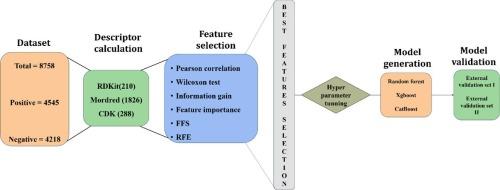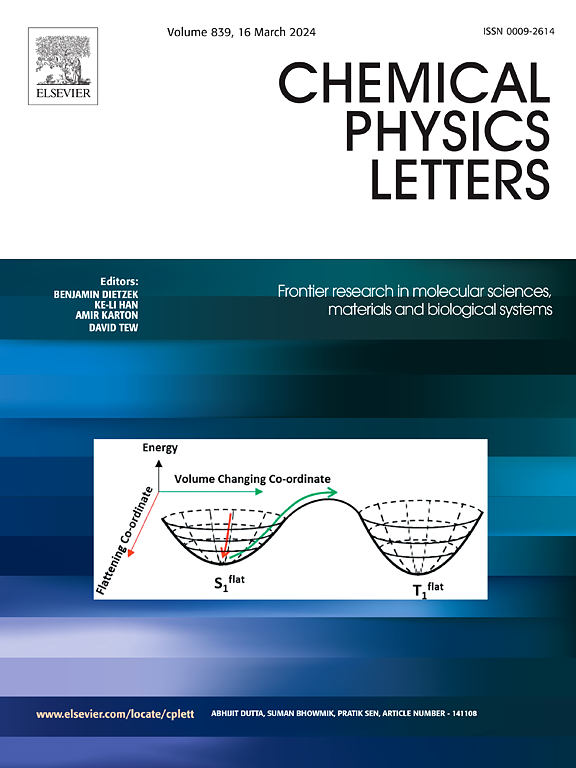为艾姆斯试验结果预测开发稳健的机器学习模型
IF 2.8
3区 化学
Q3 CHEMISTRY, PHYSICAL
引用次数: 0
摘要
致突变性是评估药物、化学品、消费品和环境相关化合物安全性的一个重要参数,而艾姆斯试验是预测化合物致突变性的一个重要试验。在数据驱动的时代,在合成和体外测试之前开发出高效的致突变性预测模型越来越受到重视。本研究开发了一种基于二维分子描述符的机器学习模型,可预测阿姆斯诱变性。本研究采用了一个多步骤过滤过程,以充分帮助识别重要的描述符。三组不同的描述符(即 RDKit、Mordred 和 CDK)被用于训练三种机器学习算法,即随机森林算法、xgboost 算法和 catboost 算法。数据集是从不同资源中收集的,用于开发稳健的机器学习模型。通过比较不同的现有艾姆斯遗传毒性 ML 和 DL 模型,进一步验证了该模型的稳健性。具体来说,包括我们的 xgboost 模型在内的 12 个模型被用于验证外部数据集,我们的模型表现出卓越的性能,AUC 达到了令人印象深刻的 0.97。预测分子遗传毒性的代码见 https://github.com/Naga270588/Genotoxicity。本文章由计算机程序翻译,如有差异,请以英文原文为准。

Development of a robust Machine learning model for Ames test outcome prediction
The mutagenicity is an essential parameter for evaluating the safety of pharmaceuticals, chemicals, consumer products, environmentally related compounds and the Ames assay is a significant test for predicting the mutagenicity of chemical compounds. In the data-driven era, developing robust models for efficient mutagenicity prediction before synthesizing and testing in vitro has gained increasing attention. In this study, a machine learning model that could predict Ames mutagenicity based on 2D molecular descriptors was developed. A multistep filtering process that adequately helps in identifying significant descriptors was adopted in this study. Three different sets of descriptors, namely, RDKit, Mordred and CDK were used to train three machine learning algorithms, viz., random forest, xgboost and catboost. The datasets were collected from different resources to develop a robust machine learning model. The robustness of this model was further validated by comparing different available ML and DL models for Ames genotoxicity. Specifically, 12 models, including our xgboost model, were used to validate an external dataset, and our model exhibited excellent performance, with an impressive AUC of 0.97. The codes to predict the genotoxicity of a molecule is available at https://github.com/Naga270588/Genotoxicity.
求助全文
通过发布文献求助,成功后即可免费获取论文全文。
去求助
来源期刊

Chemical Physics Letters
化学-物理:原子、分子和化学物理
CiteScore
5.70
自引率
3.60%
发文量
798
审稿时长
33 days
期刊介绍:
Chemical Physics Letters has an open access mirror journal, Chemical Physics Letters: X, sharing the same aims and scope, editorial team, submission system and rigorous peer review.
Chemical Physics Letters publishes brief reports on molecules, interfaces, condensed phases, nanomaterials and nanostructures, polymers, biomolecular systems, and energy conversion and storage.
Criteria for publication are quality, urgency and impact. Further, experimental results reported in the journal have direct relevance for theory, and theoretical developments or non-routine computations relate directly to experiment. Manuscripts must satisfy these criteria and should not be minor extensions of previous work.
 求助内容:
求助内容: 应助结果提醒方式:
应助结果提醒方式:


